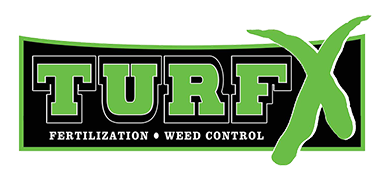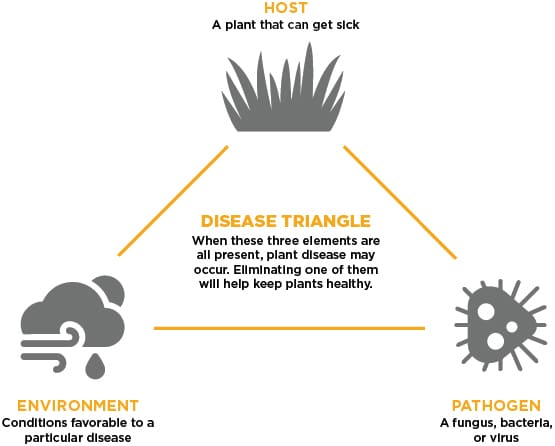Brown Patch
Symptoms:
- Rings or patches of blighted turfgrass that measure 5 inches to more than 10 feet in diameter.
- Leaf spots and “smoke rings” – thin, brown borders around the diseased patches that appear most frequently in the early morning.
Conditions Favoring Disease:
- Active at cool temperatures on warm-season grasses in the spring and fall (over85F during the day and over 60 F at night).
- This occurs in areas that experience extended periods of wetness.
Fairy Ring
Symptoms:
- Symptoms vary with causal agents.
- Aboveground mushroom and puffball basidiocarps may or may not occur.
- Typically has outer rings that are either dark-green or brown in color.
- The shape and size of rings vary depending on the species.
- Activity in turf ceases when the individual rings come in contact with each other.
- Some causal agents form fruiting bodies, but not rings and vice versa.
Conditions Favoring Disease:
- Typically occurs in the summer.
- Can also occur on cool-season turfgrass in mild winter climates
Gray Snow Mold
Symptoms:
- Evident after snow melts.
- Light brown, gray, or straw-colored patches 10 inches in diameter.
- Patches can increase to several feet and coalesce
- Rust-, brown-, or black-colored sclerotia also appear on the infected leaves.
Conditions Favoring Disease:
- Snow cover, especially snow that lasts more than 90 days.
Leaf Spot/Melting-Out
Symptoms:
- Purplish-brown to black spots with tan centers on the leaf blade and sheath.
- Lower leaves of infected plants become shriveled and blighted.
- In severe cases, almost all of the leaves and tillers die.
- Typically follows the appearance of leaf spots on cool-weather turfgrass.
Conditions Favoring Disease:
- Temperatures between 40°F and 80°F.
- Areas with 10 hours a day of foliar wetness for several consecutive days.
- High amounts of nitrogen and low mowing height.
Dollar Spot
Symptoms:
- Sunken, circular patches that measure several inches
- Patches turn from brown to straw color and may eventually coalesce, forming irregularly shaped areas.
- May display small lesions that turn from yellow-green to straw color with a reddish-brown border.
- Lesions can extend the full width of the leaf.
Conditions Favoring Disease:
- Continuous high humidity at temperatures between 59°F to 86°F.
- Favored by warm days, cool nights, and intense dews.
- Infects areas with low levels of nitrogen.
- More severe in dry soils.
Fusarium Patch
Symptoms:
- Yellow or reddish-brown patches 1 inch to 6 inches in diameter
- The periphery of patches are reddish-brown or pink in color.
- “Smoke rings”—thin, brown borders around the diseased patches that appear only in the early morning—can occur.
Conditions Favoring Disease:
- Thrives in temperatures less than 60°F in wet conditions.
- Infects areas with slow-growing conditions and heavy thatch.
- Microdochium nivale is termed Fusarium patch when it occurs in the absence of snow cover.
Large Patch
Symptoms:
- Rings or patches of blighted turfgrass that measure up to 10 feet in diameter.
- Leaf spots, blighted rings, and “smoke rings”—thin, brown borders around the diseased patches that appear most frequently in the
early morning. - Blackened or rotted sheaths and stolons of turfgrass near the soil layer.
Conditions Favoring Disease:
- Active at cool temperatures on warm-season grasses in the spring and fall (77° to 83°F canopy temperatures).
- This occurs in areas that experience extended periods of wetness or low areas subjected to standing water.
Pink Snow Mold
(Microdochium Patch)
Symptoms:
- Yellow, tan, or salmon-colored water-soaked patches that measure 1 to 8 inches or more in diameter.
- Pale pink around the edges.
- Spores are produced in white or salmon-colored sporodochia that are found on the dead tissue.
- Blighting can occur in streaks from spores tracking on the equipment wheels.
Conditions Favoring Disease:
- Favors temperatures of less than 60°F.
- More severe where snow has fallen on unfrozen soil or in cold, rainy weather.
- Microdochium nivale is commonly called Fusarium patch in the absence of snow cover—but the causal organism is the same.
Necrotic Ring Spot
Symptoms:
- First appears as thinned yellow to light-green circular patches that are 3 to 15 inches in diameter.
- It can expand up to 3 feet in diameter.
- Eventually, turn brown or straw-colored and die.
- Roots and rhizomes of the affected turfgrass turn brown to black.
- “Frog-eye”—a symptom where less susceptible grass species survive inside the diseased patch—can also occur.
Conditions Favoring Disease:
- Initiates in moist soil.
- More severe in higher temperatures (of up to 80°F) and drought conditions.
- Seeded sites, as well as sodded sites in newly cleared woodlands, are susceptible.
- Found in areas with compacted soil and are high in nitrogen during the spring and summer.
Pythium Blight
Symptoms:
- Appears suddenly during hot, humid weather.
- Greasy, brown circular spots that are initially about 3/4 inch to 2 inches in diameter.
- Rapidly enlarges in size
- Water-soaked and dark-colored early in the morning.
- Forms fluffy white masses of fungal mycelium (cottony blight) and can coalesce to form large, irregular areas of dead turf.
- Infected patches may appear bronzish-orange in color.
Conditions Favoring Disease:
- Found in areas with poor drainage and air circulation as well as in locations that are high in salinity or nitrogen.
- Favors night temperatures of over 68°F.
- This occurs in areas that experience more than 10 hours a day of foliar wetness for several consecutive days.
Rusts: Crown, Leaf, Stem, Stripe
Symptoms:
- Light yellow flecks initially on the leaf blades and sheaths.
- Flecks enlarge, elongate, and turn yellow in color.
- Infected areas rise above the epidermis and then rupture, releasing spores that are yellowish-orange to reddish-brown in color.
- Leaf-blades turn yellow, starting at the tip and progressing to the base sheath.
- Severe disease infection can cause the shoot to turn yellowish to reddish-brown in color and slow in growth.
- Turf may appear thin as individual shoots die.
Conditions Favoring Disease:
- Typically occur in early spring through fall, depending on the location of the turf.
- Favors low-light areas.
- Depending on the species, rusts favor temperatures between 65°F and 86°F.
- Severe rust infections occur on slow-growing turfgrass, particularly those with low nitrogen levels and/or plant water stress.
Powdery Mildew
Symptoms:
- First appears on the leaves as individual tufts of fine, white mycelium.
- The tufts enlarge and coalesce, causing the leaves to have a grayish-white or powdery appearance.
- Severely infected turf turns yellow, then tan and brown in color.
- Stressed turf that is severely infected can die.
- Severely infected turf, especially in shaded areas, can become thin.
Conditions Favoring Disease:
- Favored by humid, cloudy weather with temperatures between 60°F and 72°F.
- This occurs in areas under stress.
- Low light and high humidity
- Common in areas with poor air circulation, but does not require a film of water to infect turf.
Red Thread And Pink Patch
Symptoms:
- Patches that are reddish-brown in color and 1 to 4 inches in diameter up to 2 feet.
- It causes a gelatinous mass of pink mycelium with watersoaked leaves.
Conditions Favoring Disease:
- Temperatures between 40°F to 85°F and in locations that are low in nitrogen.
- Areas that experience more than 10 hours a day of foliar wetness for several consecutive days
- A pink patch usually develops in the presence of red thread.
- The two diseases often occur under the same conditions and at the same time.
By Lukas Oxborough















